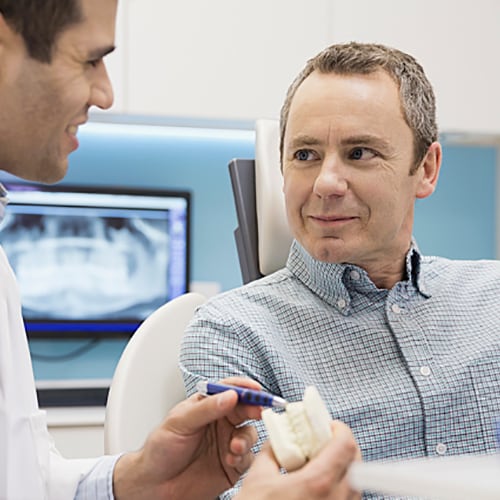3D printing is an exciting technology that has been getting a lot of attention lately. It began as a way to print out simple objects from computer models with layers of plastic. Now this mechanical process has advanced to making more complex products, such as a prosthetic hand for a growing child. The number of applications this technology is used for is growing rapidly, and dental 3D printing may soon be a real possibility. Just think, in the future if your patient needs a crown, your office may simply be able to print one. Sounds amazing!
What Exactly Is 3D Printing?
3D printing, also known as additive manufacturing, is a process by which a solid object is created in layers from a digital 3D model, as discussed by Lawrence University Makerspace. Initially the object is sliced digitally into layers after which these layers are fused together. This process was originally developed in the mid-1980s and has much potential for manufacturing in the future as the technology evolves. Numerous applications for this technology are being researched, including in dentistry.
Dental and Maxillofacial Applications of 3D Printing
The possible uses of 3D printing in dentistry could be limitless as the technology advances. One current dental application of 3D printing is the fabrication of splints for orthognathic surgeries, notes Decisions in Dentistry. Surgical templates can also be created to aid in the exacting process of implant placement. Medical researchers in Belgium and the Netherlands even replaced a woman's mandible with a 3D printed one in 2012, reports Forbes. The replacement mandible was created from powdered titanium, and the woman could amazingly speak and swallow normally the day after surgery. With more research, the outlook for the future is optimistic for the routine manufacturing of crowns, bridges, inlays, onlays and dentures.
Benefits of 3D Printing
The speed of 3D printing is an obvious benefit to the dental office. The time-consuming process of waiting on a lab is completely eliminated. According to 3D Insider, once a digital impression has been taken, a crown can be produced in under 10 minutes with the patient having the procedure completed in a single visit. As no labs fees have to be paid, the cost of producing crowns can be substantially reduced. Another benefit of 3D printing is that it is accurate up to a tenth of a millimeter. Patients with 3D-printed dentures have commented that they fit much more naturally than traditional dentures, resulting in less need for adjustments.
How Does 3D Printing Compare to CAD/CAM?
Computer-aided design/Computer-aided manufacturing (CAD/CAM) is basically the opposite of 3D printing. CAD/CAM dentistry is performed by taking a block of material such as zirconia and removing layers until a crown, bridge, veneer is formed. Basically, 3D printing is additive and CAD/CAM is subtractive. CAD/CAM technology has been increasingly used for the past 20 years in dentistry. It is most commonly used in corporate dentistry, due to high equipment costs, says the Consumer Guide to Dentistry. Both 3D printing and CAD/CAM require the use of digital scans and can allow patients to receive their restorations the same day. With 3D printing, more complex designs can be created than with CAD/CAM, which means it is suitable for more applications overall.
When Will This Technology Be Available?
As with any new technology, it will take time for dental 3D printing to be widely used in dental offices. At this point in time, there are still some obstacles to be overcome. According to Avi Cohen, a leader in the dental 3D printing industry, there is the issue of making sure the market is ready for this technology, reports Dental Esthetics. Dentists and labs have to be willing actually use it. Another concern is the problem of integrating scans from dental software into the 3D scanning equipment of the printer. Many companies are working diligently on developing dental 3D printing to make it readily available in the next few years.
Takeaways
- 3D printing is a process that creates a solid object by adding successive layers.
- There are many possible applications for 3D printing in dentistry, such as crowns, bridges, and dentures.
- It may still be a while before you see 3D printing being used routinely in dentistry.
Why It's Valuable
Dentistry is a perfect application for 3D printing, which can produce accurate results quickly in the office. This technology holds much promise in the years ahead.


Was this article helpful?
If you’d like a response, Contact Us.